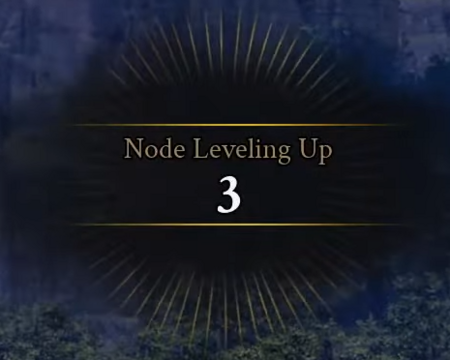Progression
Progression occurs through a variety of pathways.[1][2]
- The objective is to provide both vertical and horizontal progression.[3][4][5][6]
- Having the ability to gain power at a sacrifice... That's a way to reach a horizontal type of progression. It may not be entirely, because there could potentially be a meta if balancing isn't done correctly; but the objective there is to make sure we have both vertical and horizontal progression in the game.[5] – Steven Sharif
- Different progression pathways are designed to suit different playstyles.[1][7][8][2]
- Multiple playstyles should be relevant and viable. Additionally, you have a spread between casual players and hard-core players; and most of us exist somewhere on that spectrum. The progression path in a society or religion is more conducive to the time we have to play. Whereas, someone else may be playing several hours a day, and they have a better opportunity for the raid/level progression that might require some more dedication. So we want to have these different progression paths available to accommodate the different times in our lives that we have to play the game. And all of those types of progressions will make us relevant in some way shape or form to the general world.[8] – Steven Sharif
- Progression pathways in Ashes of Creation are per-character.[9]
- The way that Ashes is constructed is there are multiple paths of progression from a from a PvX perspective, a wide net perspective that players have interest in; and you're not going to be able to become the master of everything. So you're going to have to pick and choose, but even picking and choosing that gives you a place within that aspect of the world at a place that's going to be something that you can build up a reputation around.[1] – Steven Sharif
- The ratio that various progression systems influence player power will evolve over time. In the early game adventuring level may be the dominant influence on player power. Gear may become more influential on player power closer toward endgame.[10]
- Q: Could you explain in detail what you mean by 50% of player power when talking about gear influence on player power?
- A: That's just a general allocation of what players can expect to pursue when enhancing their player character power. Now obviously, the distribution and ratio of those types of influences, whether it be itemization, whether it be level, whether it be, augments choices, and/or skill tree choices: those influences and ratios change through the leveling curve. So, at lower levels your character level is going to be more influential over character power than itemization will be, but at endgame or higher levels, or at the end of the adventuring level progression, that's when itemization really gets an emphasis for its ratio of player power.[10] – Steven Sharif
- Repetition will not be part of progression in Ashes of Creation.[11]
- The game hosts a wide array of progression paths, and some of those paths will grant additional paths to augmenting your threat generation. This can be in the form of enchantments and stats ... and even in the form of augments granted from societies and religions. Gear and skills choice are also a big component.[12] – Steven Sharif
Leveling
One of the cool abilities we all love seeing and gives us a major dopamine response is when our character levels up.[13] – Steven Sharif
Leveling won't follow a traditional linear path, although classic mechanics for leveling exist.[4][14]
- Leveling: the act of of going out and adventuring, of killing monsters, and combat in general is the most tactile and moment-to-moment type of gameplay that you're going to experience in Ashes of Creation; and I think at every step of the way in that adventure it should be fun, and it should be something that you enjoy doing, and it should be something that's rewarding, and it should be something that teaches you more about the immersive world that you're in and allows you to follow a compelling storyline.[15] – Steven Sharif
- Players will have the option to rush their vertical progression to level cap or spend time building infrastructure through horizontal progression.[3][4][5][6]
- Experience (XP) is gained through a variety of vertical and horizontal progression paths, such as PvP, PvE, Exploration, Gathering/Processing/Crafting, Events/Quests, Grinding mobs.[16][4][17][18]
- XP will be awarded for participating in objective-based PvP on a diminishing returns basis.[17]
- A character's level is visible to other players.[19]
- Some levels may offer more rewards than others.[20]
- I think you can emphasize some levels more than others and that's a great way to do progression. But I think ultimately that you should see a reward for your progress or effort spent.[20] – Steven Sharif
- There will not be level boosts or auto-leveling (AFK leveling).[21][22]
- As part of our ideals as a game we're not going to give boosts away. We're not going to auto-level up a character. You have to spend time acclimating yourself to what this game is, to what the world that you're part of is; and that's an investment- a time investment; and that plays towards our ideas of risk-versus-reward; and I've always said our game's not going to be for everybody and that's okay.[21] – Steven Sharif
- If I have a skill that does a thousand damage to a target of equal level I don't want my skill to do zero damage to a target that's five levels above me.[23] – Steven Sharif
- A player could in theory level to max level at a single node, providing that node was at a high-enough stage, but it would not be the most effective means of leveling.[24]
End game
Ashes of Creation will not have a typical end-game where content is essentially static and repetitive. Instead, max-level characters will be able to engage with many different gameplay loops that open up based on how the world progresses over time.[25][26]
- Endgame to me communicates static. It is static structure. Okay, you've entered this loop, now and this is your end-game loop that you will repeat over and over. Whereas instead, the approach for Ashes is you have now reached a point where all of these loops are relevant; and the loops are present to you depending on how the community engages the world. And it's up to you to identify the most promising loops because you have a finite amount of time and resources in which you can engage with them. And that's then where strategy becomes a part of the picture: How will I choose to engage with these loops to maximize my return, or to maximize the specific benefit I wish to bring in individual, group, myself, or guild.[25] – Steven Sharif
- Part of the whole experience with nodes is that there is no real end-game, in that the world is constantly shifting every day. Month one is going to be really different from month two; and that's for the level 50s and level 1s.[26] – Jeffrey Bard
Level cap
The level cap at launch is expected to be level 50.[27][28]
- On release the developers anticipate max level should be attainable in approximately 45 days if playing 4-6 hours per day.[29][30]
- The developers estimate that players will reach level cap before a quarter of nodes reach Village (stage 3).[27]
- Alpha-1 had progression to level 15.[31]
- Alpha-2 expects progression to level 30 (subject to change).[32] Previously this was stated to be level 35.[33][34]
Lower level characters will have usefulness in mass combat (such as Node sieges) that is not directly dependent on their level, such as manning siege weapons, helping repair fortifications, bringing proximity-based buffs to key positions, using stealth or scaling walls. These types of things are relevant to the tide of battle and do not require the player to be max-level or have high combat stats.[35]
- The idea is not to be a game where somebody can essentially no life for a week and be max level. The idea is to incorporate some significant chunk of time but still respect the casual player, because the way we respect the casual player is not everything is driven in our game through the adventuring progression line. Not everything is driven through your class level per-se. There's a lot of different progression paths that are available and make you relevant within certain systems and mechanics within the game; and some of those paths are more casual friendly and some of those paths are more hardcore friendly. So with regards to the adventuring class, the idea is to make sure that investment needs to be pretty significant and that the reward then is respective of that investment.[29] – Steven Sharif
Grinding
Repetition will not be part of progression in Ashes of Creation.[36]
- There will be no "grindy" quests.[36]
- There will not be repetitive quest lines through a single dungeon to obtain gear.[37]
- The aspiration is to have more things to do in the game than a player has time to do.[36]
AFK leveling
There will not be AFK leveling (auto-leveling) in Ashes of Creation.[21][22]
We want this game to be played. If there are things that you can do to not play the game and still progress, we've done something wrong.[22] – Jeffrey Bard
Mentor program
There will be a mentorship program where upper-level players are able to benefit from partying and/or helping lower level players; and getting them situated in the game.[26]
- Certain node buildings and organizations offer quests that can be initiated by a mentor to assist new players. Rewards are offered to both the mentor and the mentee upon completion.[38]
- There will be activities that are present for higher level players to mentor lower level players. Let's say you have a friend who joins later on and you still want to do things with them, there will be things to do. Will he be able to enter a dungeon of your level and participate? No, because we don't want to inflate or deflate characters and manipulate that type of skill or power. We want that to be something that makes sense for them in a progression standpoint.[39] – Steven Sharif
- The mentorship program provides individual quests that can be initiated by the mentor based off of what node that they are part of. So these are like quests that are determined by either certain buildings and/or organizations or the mayor; and there are specific ones that are available for mentors to provide mentees; and they can also participate in some of those quest lines as well: Whether that be leading your mentee through a dungeon or providing a location for them to arrive with you at, or escort quests for the NPC caravans. These types of things, when done together with your mentor, will provide benefits both for the mentor and the mentee as well, so you're incentivized to participate with new players.[38] – Steven Sharif
Level scaling
Levels, stats, or skills will not be scaled to allow low level players to participate in encounters with higher level players or world bosses.[40][41][26]
- Q: Will world bosses scale when it comes to player levels and is it based on players or the zone itself leveling?
- A: They will not scale based on player level, no.[40] – Steven Sharif
Class progression
Class progression in Ashes of Creation proceeds as follows:[42]
- Players receive skill points as they level. These can be used to level up skills within their skill tree.[47]
- It will not be possible to max all skills in a skill tree.[47]
- A player may choose a secondary archetype when they reach level 25.[42][43] The combination of primary and secondary archetypes is referred to as a class.[43][46][48]
- The secondary archetype does not provide additional skills.[49]
- Secondary archetypes may be changed, but not "on-the-fly".[45][50]
- The player can then augment their primary skills with effects from their secondary archetype.[43][44]
- Class progression does not relate to a player's artisan progression.[51]
- World events do not directly impact class effectiveness but there may be ancillary effects in terms of availability of equipment, enchantments or tattoos.[52]
Classes by archetype combination
With 8 Archetypes to combine, players may choose from 64 total combinations to create their class.[43][46][48]
Class abilities
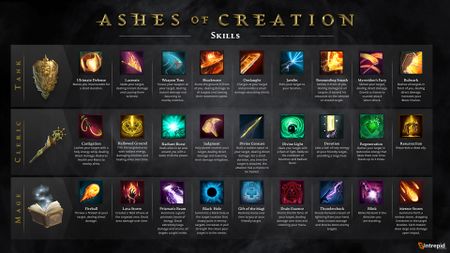
If from the eight archetypes whatever you choose as your secondary, you're going to receive a choice of augments that relate to some core ideal of that class. You know like a tank is about controlling the battlefield, is about surviving. The mage is about dealing damage and elements and ability in AoEs. The rogue is going to be about stealth and critical damage. So those augments are going to to play towards those identities.[54] – Steven Sharif
The idea behind the system is that you're skirting the line through these augmentations of your role, right. We have the traditional holy trinity that's present in class designs for MMOs and it's often that those either are not deviated at all or completely deviated from entirely. The augment is to offer a balance between that where you still maintain the semblance of that trinity system while offering the opportunity to customize your play experience towards one of the other angles in the triangle.[55] – Steven Sharif
Primary skills (class abilities) are based on a player's archetype.[56][44]
- A player may choose a secondary archetype when they reach level 25.[42][43] The player can then augment their primary skills with effects from their secondary archetype.[56][42][43][44][57]
- Outside of class-specific skills there may be a subset of universal skills, such as active block and dodge.[58]
- Class skills are not affected by the type of weapon that is equipped.[59]
- Primary skills in Alpha-2 are expected to be very different to those in Alpha-1.[60]
Skill points

What you're seeing at a high level here is just what you'd pretty much expect of a traditional skill. We're doing something a little more advanced than just like a bottom up structure, because we're being a little bit more free-form in this iteration. This will obviously see more UI iterations in the future, but you'll see a mix of active and passive abilities here. Actives are indicated by their square shape, while the circular ones are representing passives; and one thing to note as well is that these passives are aiming to be a little more interesting than just like, this ability does more damage now, or it has a lower cooldown. We do have some of those too, but the goal with a lot of these passives in addition to that is to allow people to lean into unique play styles. So you'll notice that some of them are are changing your gameplay in meaningful ways; and that's the direction we want to take um player and character customization as a whole.[61] – Tradd Thompson
Players receive skill points at specific points as they level.[62] These can be used to level up skills (increase their rank) within their active, passive or combat/weapon skill trees.[63][64][65][47]
- Making active skills capable of receiving additional skill point allocations and unlocking additional features so that from a player agency standpoint it's going to be up to you whether or not you want to be more diverse but less depth- wider and not taller, in some of these skill choices. Or if you want to be very very tall, that's going to be something that is up to the player in that regard.[66] – Steven Sharif
- Skill points will accrue at specific XP milestones, such as 1/4, 1/2, 3/4 progress through the level, so as to avoid creating an imbalance with experience debt.[62]
- We do have this concept of experience debt that does accrue and we don't want to create an imbalance between skill points acquired versus experience, so we're going to predicate your skill points acquisition based on benchmarks you reach when leveling through a level. So these are going to be at specific points in the level, like one quarter progress, to half progress, to three quarters progress: you're going to get an influx of skill points and then you'll be able to allocate them into your skill tree.[62] – Steven Sharif
- Skill points can be used to unlock universal skills at the expense of unlocking class-specific skills.[67]
- Respeccing (resetting and reallocating) adventuring skills may require travelling to a specific location rather than being able to be done on-the-fly.[68][45]
- Augments do not cost skill points.[69] It was previously stated that certain augments will have more expense required on the skill point side.[70]
- It will not be possible to max all skills in a skill tree.[47]
- In terms of skill progression, players can choose to go "wide" and get a number of different abilities, or go "deep" into a few specific abilities.[71]
Universal skills
Universal skills, such as active blocking and dodge rolling, are able to be unlocked by all archetypes.[67][58]
- Outside of your class-specific skill tree, there's going to be a subsection of a few skills that are universal, like active block, like dodge; and I think what we're going to do- or at least what we're going to be discussing here- is those universal skills will have progressions that might align with your passive tree; and you can spec skill points into progressing additional features of those universal abilities that you will have access to. So I think that's probably going to be the direction that we're going to take.[58] – Steven Sharif
- Skill points can be used to unlock universal skills at the expense of unlocking class-specific skills.[67]
- Q: Will each archetype be equally efficient with universal skills, like dodging and active blocking, or will each of them have their own versions and flavors, or will some people be more powerful than others?
- A: We want to provide a progression path that's shared for those universal skills across all the archetypes. So when you spend skill points, you can choose to spend them within the universal skill set and unlock particular ability types for the universal skills as well, but you will be spending them from the skill points that you would normally spend within your class-specific skill tree; and this offers again a different wheel of customization that I think is interesting.[67] – Steven Sharif
- The developers will be testing the use of separate energy mechanics for universal skills in Alpha-2.[72]
- Universal skill progression may align with a player's passive skill tree.[58]
Gear progression
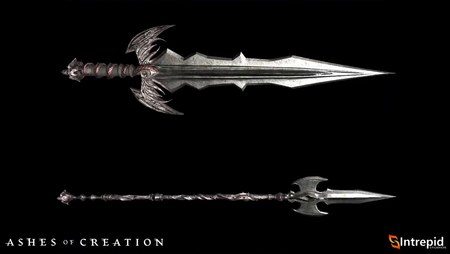
Power creep is a balance issue... When it comes to gear progression specifically, the idea is to create an open market that is not heavily dependent on soulbound items; and having many item sinks and gold sinks within that economy that allows for the potential degradation and loss of assets within that closed economy; and not introduce items from the market that companies put in from a pay-to-win perspective or from a pay-to-convenience perspective that undermines the economy that players have built. That is a huge mistake that companies have made in the past and that lends to the imbalancing of what designers maybe have actually balanced well.[74] – Steven Sharif
Weapons have their own progression paths.[75][76]
- Each type of weapon has its own skill tree that grants passive skills and proc effects and other status conditions.[77][78][79][80][81][82][64][65][75][83][84]
- The weapon combo system determines special effects that proc based on weapon progression.[75][84]
- Ancillary effects proc based on enchantment types.[84]
- Gear enhancements (power stones) can be applied to add elemental or energy types of damage.[84]
- Dual wielded weapons will have its own progression based on weapon type.[85]
- Weapon proficiency (based on length of use of a weapon) is not a planned feature.[83]
- Ashes of Creation is all about providing many progression paths... The reason why we don't like the term endgame is because with the amount of progression that's available with the amount of diversity and player agency that impacts the world... We want the weapon system [to] add an element of that as well... You can determine special effects that proc from currently the combo system; you can determine ancillary effects that proc based on enchantment types; you can power stone weapons to add different either elemental types of damage and/or energy that play rock-paper-scissor with player defenses ... and then you can skill tree out how those effects that are granted ... you can make them better you can branch them off into a different direction.[84] – Steven Sharif
Gear enhancement
Gear enhancements are possible both during and after an item is crafted.[86][87]
- There is a combination of systems that take an item to its max potential. Players will need to contribute in a certain number of these systems to reach max. Some of the systems are an either/or situation.[86] – Kory Rice
- Crafting recipes can be enhanced by adding higher rarity or different crafting materials into their selectable crafting slots at crafting stations.[87][88][89][90]
- Enchantment scrolls and tempering allow gear to be enhanced post-crafting.[87][91]
- The bulk of a weapon's power comes from its crafting recipe and the materials used in its construction.[92]
- The contribution of materials to crafting an item results in advancing the rarity of that item. Now, that doesn't exclude players who don't have the legendary or the higher quality contributed resources from progressing their common item up the rarity tree through enchantments such as scroll enchanting or through tempering the gear. Both of those can affect the quality and the rarity of the gear that you produce, but by contributing the resources during the crafting process you are getting a head start with the higher quality item and now are less dependent on those other avenues to achieve that, which might be again a different vertical space of progression that you don't have as good of access to.[87] – Steven Sharif
- Runes/Power stones are a potential methods for enhancing weapons.[84][93]
- Enchantment stones are potential rewards for performance over six month PvP seasons. These grant temporary PvP-focused benefits to gear (via a socketing system).[94][95]
Enchanting
Enchanting is not an artisan profession in its own right. Scribes create scrolls that can be utilized by different professions to create enchantments relating to that profession.[96][97]
- Enchantment scrolls can be sold on the open market.[87][96][98]
- Enchanting does not increase an item's level requirement.[99]
- You don't really push a particular item's level requirement or the identity of that item. You can enhance it, you can add enchantments to it, but it's still the item it is.[99] – Steven Sharif
Power creep
The developers intend to limit power creep via item sinks, the lack of gear binding, and the absence of pay-to-win or pay-to-convenience in Ashes of Creation.[74]
Pet progression
Combat pets will be levelable and will have gear available to them.[100][101]
- Combat pets will incorporate some of their owner's power in a way that keeps the power progression horizontal.[102][103][104]
- Power is delegated to the pet when it is summoned and returned to the player immediately when the pet despawns.[105]
Summoner summons (Summoner pets) do add to the summoner's power when they are summoned.[102]
Combat pets, which can be acquired by any archetype- and this is essentially an item that exists within your backpack- you cast the item to summon your pet. When it is summoned it's not intended to be a vertical gain of power, because when you make combat pets a vertical power gain, then it becomes a no choice solution: you must have a combat pet if you want to play efficiently- you must have a combat pet; and I wanted to steer clear of that because the way I wanted to approach combat pets was more of a horizontal power choice; meaning: depending on the type of encounter you're facing, depending on the threat assessment you have, a combat pet might be relevant, or it might not. One combat combat pet might be more relevant than another combat pet and that's part of your gear acquisition, your item chase to attain this more comprehensive selection of combat pets that you can have available to you and can be summoned in the event that you want to engage an encounter with a different aspect of your power curve: Not vertical, but horizontal.[102] – Steven Sharif
Artisan progression
| Artisan level | Artisan certification | Profession limit per character |
|---|---|---|
| 1-10.[109][110] | Novice.[106][111] | 22.[106][107] |
| 10-20.[112][110] | Apprentice.[106] | 5.[106][107] |
| 20-30.[112] | Journeyman.[106][108] | 4.[106][107] |
| 30-40.[112] | Master.[106][108] | 3.[106][107] |
| 40-50.[112][113] | Grandmaster.[106][108] | 2.[106][114][107] |
Artisan progression occurs based on experience (repetition of tasks) as well as achievements of certain benchmarks within each artisan branch (Gathering, Processing and Crafting).[116][117] Progression in each artisan profession is per-character.[118][119][120][121]
- All 22 professions, the players get to be novice of; and then it starts narrowing from there. So, after that you'll only be able to be apprentice of five things. You can be a journeyman in four things. You can be a master in three things; and you can be a grandmaster in two things. So you'll need to narrow, but you can also diversify to support the professions that you want to first push further in.[107] – Kory Rice
- Progression to each "tier" within a profession grants skill points that can be utilized in a character's artisan skill tree.[123]
- Artisan certification quests must be completed to gain proficiency in that tier of artisan progression.[116] Completing certification unlocks benefits for that profession, such as artisan tools for gathering professions and recipes for crafting professions.[86][124]
- There are limits to the number of professions at each certification tier across the three artisan branches.[106][114][125][107][126] For example: a character may only ever be a Master in up to 3 professions and Grandmaster in up to 2 professions across all artisan branches.[106][114]
- Grandmaster artisans can max out their entire profession skill tree, but a character can only be a grandmaster of up to two professions.[127]
- Achieving an artisan certification in a profession also implies that the character also achieved any lower-tier certifications up to that point.[128]
- If you are grand master in that profession you can max out the entire tree. But you can only grand master 2 things.[127] – Kory Rice
- Choosing a specific path in the skill tree allows the player an opportunity to specialize in a certain area. This encourages player inter-dependency, enhancing the artisan experience.[129]
- Progression within artisan classes does not directly relate to progression in a character's adventuring class, but there are requirements that take into account dangers, locations, toolsets, and surveying options that are dependent on adventuring level.[130][131][51]
- Characters gain XP as they progress their professions.[16][124]
- It should be expected that some artisans will have significantly higher artisan level than their adventuring level.[16][130]
- Q: In regards to character level and artisan level. We know that currently there are two separate things. That being said, what prevents a player from staying level one and partying up with a level 50 player to then gather level 50 resources in the high zones? That way, anyone who wants to take those resources will have to kill the gatherer who is level one and get a large amount of corruption for killing a level one as a level 50.
- A: Gathering higher level resources requires significant advancement within a particular profession for that gatherable resource. So, if I'm a Miner and I want to access the highest possible mineral, I need to be a master miner; and in order to achieve the master minor status I am going to be gaining adventuring level experience through that process, because many of those quest lines, many of those achievements are facilitated through quest lines. Some of those quest lines interface with adventuring difficulties that are out in the wild at certain levels. So that's going to predicate me- that's going to be a predicate for me to achieve a certain level in order to complete some of these quest lines and achieve that master status. So you will you will likely not see the ability of a level one alt character having the access to high level mineral mining, or any other type of gatherable out there.[130] – Steven Sharif
Artisan mastery
A character may only ever be a Master in up to 3 professions and Grandmaster in up to 2 professions across all artisan branches.[106][114]
- Artisan mastery is no longer restricted to a single branch.[114]
- Characters may change which professions they master.[132]
- Becoming a master Crafter or a master Processor or a master Gatherer should be a significant time investment and resource investment; and because of that it should also be something that when you achieve that status it's like people on the server know who you are.[133] – Steven Sharif
- Masteries aren’t just about making an item. They grant many things, including titles, access to items, bargains, and quests. [134]
- Previously it was stated that with considerable effort a player can master all professions within a mastered parent artisan class.[135][136] This was later changed to a player being able to master some but not all professions within a mastered parent artisan class.[137][138] This was changed to being able to master up to two or three professions within a mastered parent artisan class (subject to testing).[119] This was changed to being able to master up to two professions.[118] The current stance is only being able to become a Master of 3 professions and Grandmaster of 2 professions across all branches.[106][114]
- Q: What would be the daily activities for someone at level 50 with a maxed out artisan tree?
- A: The daily activity might be something along the lines of, depending on what type of profession or processor you are, of interacting with fellow artisanship individuals to wheel and deal on supply and demand chains; orchestrating and participating and caravan roads that move materials across the world so that you can satisfy buy orders and/or commission requests. Participating in unique trades and/or dungeon experiences that have the opportunity to acquire unique crafting materials so that you can create the dragon's legendary sword and sell that potentially. Finding unique harvestable materials in remote parts of the world or engaging in treasure map finding for again unique materials and/or processing things. There's a whole host of different intents that are loops for the players to participate in that again are situationally relevant based on the world state.[25] – Steven Sharif
Gathering tools
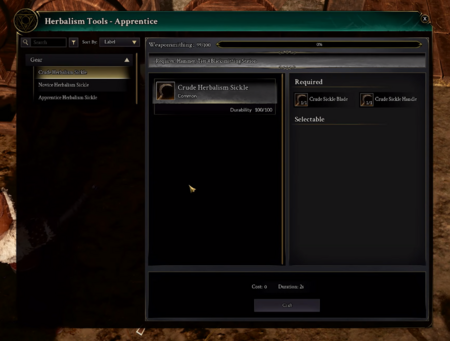
Different professions will have a number of quests available to introduce players to their first toolsets; and then, their toolset sustainability will be incumbent on the player to continue to gather the resources necessary to repeatedly create these tools, because they have a durability that gets expended when interacting with the resources in the open-world.[140] – Steven Sharif
Each gathering profession will have three tools. The tools come online as you progress through the profession; and the different resource types for each one of the professions may require different tools. So, you basically want to carry around the right tool for the job. And tools along with artisanship gear will have stats on it, so you can itemize towards how you want to gather, how fast you want to gather.[141] – Kory Rice
Gathering tools (also referred to as harvesting tools, artisan tools, and toolsets) enable the gathering of resources in Ashes of Creation.[141][142][143][144]
- Each gathering profession has three gathering tools. Each tool allows gathering of different resource types.[141]
- Gatherers must meet the required artisan certification to utilize tools of that level (or lower).[147]
- Gathering tools are equipped to a character's artisan tool slot.[110]
- Progression in the gathering artisan class unlocks higher level harvesting tools that enable gathering of higher level resources.[141][148][149]
- Artisan progression unlocks higher level surveying tools that enable better identification of gatherable resources within a location.[149]
- Higher level of progression can also speed up gathering times, resource yields, and may allow access to resources at earlier growth stages.[145][146]
- A gatherer at maximum proficiency will unlock master toolsets that will grant them access to the highest quality gatherables.[13]
- Tools do advance within the artisan tree, so your ability to either gather, process or craft will require the equivalent tools necessary at that stage of crafting in order to accomplish the task at hand. So, you could not mine copper and mithril with the same tool.[144] – Steven Sharif
- Tools will have durability and lifespans.[140][13][150]
- Artisans will not need to rely on other trees in order to make their tools.[143]
- The developers are considering the introduction of gathering tools that require two players, such as two-person saws that can fell larger trees.[148]
- Your progression within the profession will take account what tools you can use. There might even be some opportunity to do some gathering with other players that . Typically in other games that I play you usually do the gathering alone. You're venturing around alone; and we wanted to take a look at maybe having a friend to help you with a two person saw on a larger tree. Maybe there's some panning that you could do as opposed to just hitting with the pickaxe. So, we'll have other tools that are part of that progression path and other activities that players can do if they would like to gather together.[144] – Kory Rice
Legendary items
There is a small RNG chance of looting rare and legendary items or crafting materials from mobs based on the level, status and type of mob. This also applies to harvesting resources with a gathering profession.[151]
- There is a much higher chance that materials and unique recipes are dropped that can be used to craft items of equitable value.[152][153][154]
- Legendary equipment is only dropped by Legendary world bosses.[155]
- Legendary equipment will have a roughly 6-12% improvement in base stats, subject to testing and balancing.[156]
At each stage from Gatherer to Processor to Crafter you are required to have certain prerequisites before those elite types of materials can be essentially gathered, processed, or crafted.[153] – Steven Sharif
- Gatherers must have high quality tools to gather rare resources.[153]
- Processors must have high tier processing buildings on their freehold to produce rare materials.[153]
- Crafters must also satisfy certain prerequisites to craft legendary equipment.[153]
The amount of effort needed and interdependencies across the different types of players – between raiders and PvPers and crafters and even role players and the taverns and businesses: the processors and gatherers – all of those systems will likely have a component that lends toward creating or crafting that legendary item... We want to stay away from the highly RNGd system, and instead take our multiple progression paths that we are offering the players and put the construction components for achieving these legendary items within them so it encourages communities to work together because it's going to be difficult for just one person by themselves to gather everything. Not to say that they couldn't in an economic sense, by buying those components, that's possible. But achieving them from a time investment standpoint we want it to be considerably less RNG focussed.[154] – Steven Sharif
Certain legendary items may be limited to one per server at any given time.[157][158]
- If the player character leaves the server then the item will become available for acquisition through whatever means it was acquired previously.[157]
There are absolutely legendary items and they're not items that are attained easily nor are they granted out in a volume. There might even be items that are single items that will exist on the server at any given time.[158]
A legendary weapon is easily distinguished by its visual appearance.[154]
It will be a very ornate and detailed weapon, more so than any other weapon or piece of equipment in the game. It will also include some awesome looking effects that won't too gaudy, they won't be too bright and shiny so that it doesn't look good, but they will be subtle and people will notice it and know wow that guy has this weapon.[154] – Steven Sharif
Legendary items are not intended to be temporary.[159]
- A notable exception to this is Royal mounts.[160]
The fact there is only one of them... or very very few of them depending on what it is. I think that in and of itself is a balance component right and you need to make sure that the players who are striving for those legendary things and who are devoting the time energy, resources in order to achieve them are accurately rewarded... We do not intend on having legendary items that are temporary.[159] – Steven Sharif
Discovery of legendary items will unlock further chapters of the Lore.[161]
Religion progression
There are player progression paths within a religion.[162][163]
- Players may follow only one religion at a time.[162][163]
- Religious progression is based on quests that are only offered to followers of that religion.[162]
- Religions have a ranking system based on a player's performance in these quests and the number of quests completed.[162][164]
- Changing religion will cause loss of progress in a player's previous religion.[162][163]
- It depends on their dedication to the religion itself; their performance when it comes to certain religion's religious objectives; their contribution to the development of that religion within the world. There's a lot of different markers that we use at each stage to determine how they progress within the religion.[165] – Steven Sharif
Mariner classes (also referred to as boatsmanship classes, boatsman skills or seamanship) contain different skill trees arranged in a similar manner to Artisan classes. As a player gains experience in these different skills they become more adept at using them.[166][167]
- Interaction with attachments, such as gunnery.[166][167]
- Piloting/driving the ship.[166][167]
- Ship navigation.[166][167]
- Utilizing ship components, such as furling the sails.[166][168]
- Ship repair, such as the speed and amount of health restored.[166][167]
- Defensive skills.[167]
- Utility based skills.[167]
- The benefits of having Mariner expertise is not just related to activities you can do on the ships, but will also incorporate skills that become available when you're piloting ships as well. There's a few things that Mariner classes provide: interaction with attachments on the ship, driving the ship itself, utilizing the ship's components—like furling the sails or not—as well as repairing ships when damage is taken—the speed at which you can do it, the health you regenerate when you do it.[166] – Steven Sharif
Event levels
The level of a particular event can be based on the level of the content that triggers it, or it can be set to a higher level in order to drive traffic back to lower level zones.[169]
- For example, if the event takes place in a zone that has a base population of let's say average level 25, then one of the trigger conditions might be that 10 monsters of level 25 have been killed recently in that zone and the level 25 event will now spawn additional content designed for level 25 players. So these events aren't always going to be end-game they're going to be obviously appropriate based on the content in which the predicate system is informing, but they also could be something completely top level that is introduced at a lower-level area and brings population traffic of the players back to those types of things.[169] – Steven Sharif
- The more players participating in an event the more challenging the event will become and the higher the rewards will be for completing the event.[170][171][172]
Node stages
Nodes advance by collecting experience from the actions of players nearby. As players complete content inside of a Node’s Zone of Influence (the area around the node), they contribute that experience toward the Node’s development. The experience given to the Node may then be modified based on certain Events and Accomplishments. When a Node reaches the experience required, it undergoes the process of advancing to the next stage. There are a few exceptions where a Node cannot advance even though it has the required experience - most commonly, a Node can not advance if a Node is a Vassal of another Node and would advance to the same stage as its Parent Node.[173] – Margaret Krohn
Nodes have seven (7) stages of advancement, with experience thresholds for each stage. When a Node reaches the experience required for its current stage, it advances to the next stage.[174]
| Node stage.[175] | Symbol | Alternate name.[176] | Timeframe to advance.[175] | Player housing.[177] | |
|---|---|---|---|---|---|
| 0. | Wilderness | - | |||
| 1. | Expedition | Crossroads | Few hours | - | |
| 2. | Encampment | Camp | Many hours | - | |
| 3. | Village | - | Few days | Small houses | |
| 4. | Town | - | Many days | Medium houses | |
| 5. | City | - | Few weeks | Large houses | |
| 6. | Metropolis | Metro | Many weeks | Mansions |
Node progression
Citizen and non-citizen player activity (questing, gathering, raiding, etc.) within a node's ZOI counts toward that particular node's advancement (progression) to a higher node stage.[173][175]
The advancement of a node unlocks its unique content, which comes at the cost of locking out an increasing ring of neighboring nodes from progressing to the next stage.[179]
- Nodes advance to the first stage quickly. This enables NPC services such as vending or banking items.[180]
- The more advanced the node is, the larger its ZOI becomes.[181]
- Less advanced nodes (referred to as vassal nodes) that fall within a more advanced node's ZOI can still gain XP, but must remain at a lower advancement stage than the dominant node.[182]
- The vassal system begins when a node hits Village (stage 3), but neighboring nodes starting from Expedition (stage 1) also block the growth of their immediate neighbors.[183][184]
- Certain quests, such as story arcs, may not be able to be turned in after a node has advanced.[185]
- The territory expansion algorithm takes into account the nearest coast, neighboring nodes, and the heatmap of players in surrounding areas over the last weeks or month.[186]
- Due to the way the progression algorithm calculates territorial (ZOI) expansion during node advancement, there is a small possibility that two nodes of the same stage end up being close to each other.[187]
- The way that the algorithm expands the territories takes into account a few things: One it takes into account the coast like where's the closest coast. Two it takes into account the neighboring nodes so it can take over and essentially vassal state those nodes, but what's more important is essentially the initial population based on like how players choose their races. Because we have nine different races and four different starting points that branch out, each server's population density is going to dictate essentially the first few nodes that are highly populated and then that initial seed is what's going to determine the node structure as it moves inland into the into the world essentially; and based on the performance and successes of different sieges will determine which nodes that got locked out from the previous the initial advancements what nodes can now be available to advance further. So I really think that with so many variables that are present in the equation of how nodes advance and stay existing with the more variables you have, the higher likelihood there is for there to be a significant diversion in world progression.[186] – Steven Sharif
- Normally the algorithm that's applied to the node territorial expansion will prevent significant nodes from being in close proximity to each other... There could be a perfect storm where all of the algorithmic progression of territory leads to having these nodes very close to each other because there's certain requirements that should that need to be available to satisfy node vassal takeovers; and it's possible that two nodes would never take each other over as vassals and end up close together and spanning their territories in opposite directions: The Tale of Two Cities thing.[187] – Steven Sharif
- A node does not receive XP from the nodes within its ZOI until these nodes have reached their cap.[182]
- Node experience gain opportunities will be equitable across the four node types.[189]
- Different people have different resources invested in nodes progressing and it would be a little "gamey" if you could know exactly what was necessary at that point because that would disincentivize people from participating.[190] – Steven Sharif
Node advancement spawns a series of animations and visual effects (within the footprint of the node).[191][173]
- Players within the node are teleported to a safe location, likely a respawn area near the node.[191][192]
- Supplies will spawn around the node and system driven caravans are spawned to bring these supplies into the node. These caravans are not able to be attacked.[191]
- NPCs will begin construction activities.[191]
- Players outside the node will see the new facade of the node pop into existence as the node advances in stage.[191]
- The Development Area of a Node is where civilization will appear as the Node advances. As the Node Stage increases, different buildings, NPCs, and services will become available in the Development Area. The higher the Node Stage, the more complex and populated the Development Area becomes. Development Areas will also vary depending on the Node Type - Economic, Military, Scientific, or Divine.[173] – Margaret Krohn
Vassal nodes
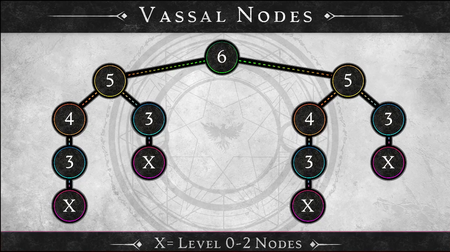
This vassal mode structure tells you what it looks like for a sovereign at a level six metropolis stage; and what it can control at a maximum vassal network is two level five nodes, of which a level five node can control one level four and one level three as direct vassals; and then the four can control a three; and every three can control a one or a two. Now if the three gets removed through siege, the one or the two is removed as well. So that's an important distinction between the three's vassals, which technically isn't really a vassal relationship because there's no citizenships possible. Those vassals don't exist between three and X, but they do exist between four and three, five and four, and six and five. And what this also allows is that because there are 85 nodes that are within the world, we have a buffer zone of about 20 nodes that lives in a max server state. So if you had maximum five metropolises form in a world, you will have a number about 20 nodes that can live alongside those metropolis networks; and when or if a metropolis falls, that extra cushion of nodes around the five metropolis structures allows for the map to be redistricted in a way that is unique. It doesn't mean that one of the fives is just going to pick up where the last six left off and form the same exact metropolis structure. From a territory perspective it has ancillary nodes to play with and expand towards that redistricts the map, so that if a metropolis falls there's a significant difference in the layout of the world and the layout of these almost nation-like territories.[193] – Steven Sharif
Village (stage 3) or higher nodes enslave nearby nodes, converting them into vassal nodes.[174][184]
- A Metropolis (stage 6) can control up to two City (stage 5) nodes. A City (stage 5) can control one Town (stage 4) and one Village (stage 3) node. A Village (stage 3) can control an Encampment (stage 2) or an Expedition (stage 1). If the Village (stage 3) gets destroyed through a siege, its dependant Encampment (stage 2) and Expedition (stage 1) nodes are also destroyed.[193]
- There is a layer of intricacy between how the neighboring nodes advance and what potential parent structure they have in the vassalship tree.[194] – Steven Sharif
- Vassal nodes gain benefits from their regent node (also referred to as sovereign node or parent node) even if the node type of the parent is different to the vassal.[195][196]
- It is not a bad thing to be vasseled, it is a good thing to be vasseled. It brings many benefits from the Sovereign, which is the ultimate parent of that vassal network down to the vassal node itself; and it allows that vassal node to even live outside of its normal mechanics. You get to adopt some of the benefits that the node type of your sovereign is, even if your node type as a vassal node isn't the same.[196] – Steven Sharif
- Regent nodes collect taxes from their vassal nodes. These taxes cannot be taken by the mayor or other players.[198]
- Vassal nodes must remain at least one node stage below their parent node.[174]
- Neighboring/Adjacent nodes from Expedition (stage 1) upward block the growth of their immediate neighbors. This was intended to be tested in Alpha-1.[183][184]
- Vassal nodes first apply any experience earned to their own deficit (see Node atrophy). It then applies excess experience earned to its parent node.[173]
- If the parent node advances, the vassal is once again able to advance.[174]
- Vassal nodes give excess experience to their parent node and may have their own vassals; so long as they fall within the parent node’s zone of influence.[198][174]
- If a node is capped and is both a vassal and has its own vassals, any experience earned from itself or its Vassals is first applied to its own deficit. Experience beyond that is then sent to its parent node.[173]
- When the vassal reaches its cap it overflows experience up to the parent; and so it can be very good early on for parents to get vassal nodes that are very productive- that have a lot of traffic.[198] – Steven Sharif
- Vassals are subject to the government, alliances, wars, taxes, and trade of their parent node, and are able to receive federal aid from them.[174]
- Vassal nodes cannot declare war on their parent node or any of their vassals.[174]
- Citizens of vassals are bound by the diplomatic states of the parent node.[174]
- If a Node is a Vassal Node and is capped from advancing further, it first applies any experience earned to its own deficit (see Node Atrophy section), and then applies excess experience earned to its Parent Node. If the Parent Node advances and the Vassal is able to grow, it becomes uncapped. If a Node is capped and is both a Vassal and has its own Vassals, any experience earned from itself or its Vassals is first applied to their own deficit. Any experience beyond that is then sent to its Parent Node.[173] – Margaret Krohn
Adjacent/Neighboring nodes
Adjacent nodes (Neighboring nodes) starting from Expedition (stage 1) may block (lockout) the growth of their immediate neighbors.[183][184]
- Vassal nodes must remain at least one node stage below their parent node.[174]
- Encampment (stage 2) and Expedition (stage 1) nodes are technically not vassal nodes as they do not support citizenships. If their parent Village (stage 3) node is destroyed by a node siege, these nodes are also destroyed.[193]
Node layout and style
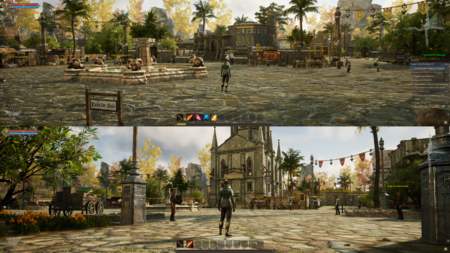
The layout and architecture within a Node’s development area are determined by influential race. For example, a stage 3 Node with the majority of player contribution being Py'rai would have a Py'rai village with Py'rai architecture. Most NPCs would be Py'rai elves, and offer questlines within the Py'rai narrative.[174] – Margaret Krohn
Each player’s contributed experience is flagged with their character race and other identifiers. When a Node advances, the race with the highest experience contribution determines the Node’s style and culture. This style and culture change can happen at every Node Stage. For example, if a Node advances to Level 2 - Encampment Stage and 51% of all experience was earned by Ren’Kai players, the Node will be a Level 2 Ren’Kai Node. If that same Node advances to a Level 3 - Village Stage Node, but the Py'Rai contributed 62% of all the experience earned, then the Node will be a Level 3 Py'Rai Node.[173] – Margaret Krohn
Node layout and style is determined by several factors:[199][200]
- The way that the node system is built is that they can exist across a spread of 18 biomes, but at the same time have to represent the cultural influence of these cultures that are intrinsically a part of a specific biome.[201] – Steven Sharif
- Environment (biome) and location of the node.[201][199][200]
- Nodes will adjust the local topography to fit the aesthetic and mechanical requirements of the node.[202]
- Currently the way that the platform system is set up, is it's capable of adjusting the topography of the node's footprint, regardless of the surrounding terrain. So the reason for that is we want to have flexibility in the presentation of the node's layout and how it is essentially both from an aesthetic standpoint as well as a mechanical standpoint with node sieges- how it's constructed and that construction should have the ability to take on a variance of different types of topography. So it shouldn't be dependent on the surrounding area. Now that's not to say that the surrounding area isn't going to have some influence over. So for example... we're experimenting a little bit with the platform tech and putting up a node up against the side of a mountain or on the edge of a cliff or something that has a beautiful vista. Those are things that we're going to test out obviously as we continue to work on the node tool and how that platform system works, but the idea is to have the node independent of the surrounding terrain.[202] – Steven Sharif
- Some parts are determined by the area it's in. Some parts are determined by the type it is. Some parts are determined by the race it is; and then the rest of it is determined by the mayor.[200] – Jeffrey Bard
- Race that contributed the highest percentage to the node's advancement will alter the racial appearance of its buildings, NPCs, and props.[203][204][199][173][200][205][206]
- All nodes, whether they're associated with a castle or associated with normal node structure, has cultural influences that replicate over to the buildings that are produced and the NPCs that are present.[208] – Steven Sharif
- The rest is determined by the node's mayor.[200]
- It should be possible for a node to complete several building projects within a mayor's one month term in office.[209]
- Q: How long would you say it will take players on average to fill/build up a node completely from wilderness to metropolis?
- A: It's one thing to get a node to a certain level: it's another thing to develop the node; and I can't really give you an on-average expectation, because there's a lot of variables at play. There's how many citizens does the node have attracted to it; what's the type of traffic that the node is attracting to it based on things like its tax rates, or the specialization that it chose to spec into, based on the building types it's chosen to build. All of those things are variables that can affect the quote-unquote "average build-out time" of a particular node. So it's difficult to give you an average when there's so many variables along those lines. But the idea is that if there is a particular project that players are interested in in developing based on the node stage, that they would have the ability to complete several of those projects as within a single term of a mayor; and a term of a mayor is one month.[209] – Steven Sharif
Racial influences
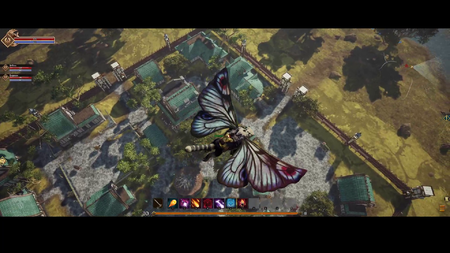
We have essentially sets that exist across all races; and each race that dons those armor sets is going to have their own racial influence on the presentation of those particular sets. So that's something that's unique in how each of the races get diversified. Additionally, the more that one particular race contributes to a node's development, it's going to manifest in that particular node's architectural influences. You're going to see the architectures of those races become manifest within the nodes as well: That's another way that we diversify each race and we present each race's culture in the game as through those architectures, through those props that exist, through the tailoring of the armor sets that the NPC might wear, to the different factions that exist. Factions will have their own affiliation with different races as well. Each race will also have some different nomenclature when it comes to the lore, or comes to locations in the world. They're going to have their own language influences as well: The way they speak is something that's going to be distinct between races; when you have dialogue trees with particular NPCs. So all of those things really go into setting an immersive world where the cultures have their own identity.[203] – Steven Sharif
Cultural influences manifest in many ways, from node and gear aesthetics to NPC languages and lore.[203][211][173]
- Gear appearance of certain armor sets is influenced by the player's race.[203]
- Node layout and style is influenced by the race that contributes the most to that node.[203]
- There is an attrition and that attrition on experience and influence is heightened based on the performance of the race in the world. So if all these nodes are Orc nodes then their attrition rate is very high to compete with the cultural establishment of new nodes because they have more influence in the world and a popular opinion is against them in their outlying regions that they do not have influence in.[212] – Steven Sharif
Zones and progression
Dungeons, Raids, World bosses, Mobs, Quests, Events, Resources, Narratives and other content within a node's ZOI will have a diverse level range; but will scale with the advancement of that node and its racial influence.[213][214][174]
- Portions of the spawn tables (for mobs and resources) are static and other portions are dynamic and adapt to node development.[215]
- We don’t have a strictly level 25 zone. Instead, that zone might have some level 10 creatures near the road, some level 20 creatures deep in the forest, and some level 30 creatures up the mountain. These ratios will change based on the Nodes that inform them, becoming generally more dangerous as the Node grows. All this civilization attracts the attention of Things-That-Should-Not-Be. This does not mean that wilderness areas are safe, by any means. Some may be safe-er, but all will have dangers that even the most experienced traveler needs to watch out for.[216] – Steven Sharif
Guild progression
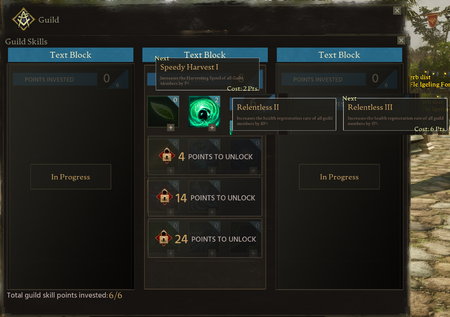
As you're leveling up the guild and you're getting these points to either allocate towards expanding the guilds member count or allocate towards adding certain passive abilities that your guild members can gain by being guild members. You're also going to see as you're leveling up the guild through different type of quest-based, participation-based, node-based, organization-based systems and ways that those quests hook into the world. You're also going to see perhaps some augment abilities at the upper tiers of the guild levels become unlocked for certain members that have a classification of officer or knight, will have access to those different types of augment abilities that might get unlocked should you go down the non expansive member lane; and the idea there is to offer these benefits to smaller groups.[217] – Steven Sharif
Guild progression occurs through participation in different systems.[217]
Guild progression grants skill points that the guild can allocate to unlock aspects of their skill tree, such as passive skills, augments and membership count.[217][219][220]
- Passive abilities increase certain stats relating to a guild member's ability to perform in combat or in other aspects of the guild, such as the economy.[217]
- Augments may apply at the upper tiers of guild progression.[217]
- Guild members do not need to be citizens of the same node in order to benefit from passive skills and augments.[221]
- Guild size can be traded off for guild progression.[217][222]
- The higher the guild's member cap, the fewer available skill options will be available to that guild.[223]
- Guild alliances may be a key part in creating a larger "guild".[222]
- Guild halls can be unlocked at a certain stage of guild advancement.[219]
- Guilds cannot respec their skill points once allocated. This is subject to testing.[224]
- It's not always going to be combat. You could have an economic focus guild. You could have a trade oriented guild; and there's all sorts of things that you can put together and give your guild its own identity.[217] – Jeffrey Bard
Social organization progression
Social organization progression is achieved through accomplishing tasks or quests within that social organization.[225]
- Some progression is static, but more competitive achievements will be seasonal, based on a ladder system.[226]
There are hierarchical paths pertaining to specific questlines for the organization's thematic.[225] These quests will either be cooperative with or adversarial against other nodes based on their mutual war status.[227]
- - For example, a Thieves' guild may have objectives and quests toward securing a particular item to enable players to advance within the organization.[225]
- Social organizations are going to have questlines that players participate in which some will include sabotage, espionage, intrigue... While it's not necessarily player versus player in the combat sense, it is player versus player in pitting communities in those organizations against each other in a competitive atmosphere, where only some things can be accomplished by certain communities; and not everybody can succeed at a particular task. So, I think that that's a unique way to involve meaningful conflict that doesn't necessarily have to relate to PvP, because obviously we have a lot of PvP systems in the game and and there are many ways for players to participate in player versus player combat; but we also want to make sure that from a progression standpoint, from a system standpoint there are going to be abilities of individuals to follow these questlines, these tasks that will pit organizations against each other, specifically from an organizational standpoint.[228] – Steven Sharif
Social organization augments
Social organizations unlock Up to 3 or 4 augments based on:[229][230][231][232]
- Whether the organization is the patron of their node: Meaning it contributes the most amount of work to the node from its members.[231]
- A player's progression within that organization.[231]
- You're gonna see augments being used a lot throughout a lot of our systems. When we're talking about the guild system, when we're talking about social organizations, when we're talking about religions. A lot of those things are going to affect how and what you have available to augment your skills with.[232] – Jeffrey Bard
Alliance progression
Ashes of Creation may have specific content that revolves around Alliances.[233]
- Progression pathways within alliances.[233]
- Guilds sharing common services with alliance members.[233]
- Node alliances.[234][233]
- Content that revolves around alliances specifically and progression within the development of that alliance; and the ability to share some common services between guilds that are part of that alliance. I think that additionally allowing alliances to toggle certain relationships with nodes as an interaction is beneficial. That's going to provide an interesting dynamic for players who are either members of the particular node that has the relationship established or members of the Alliance. So I think that obviously building systems is is about creating the channels by which these players can form bonds and the more layers you have around those channels of bonding between the different guilds or players, the more sustainable that relationship.[233] – Steven Sharif
Freehold progression
Freehold progression unlocks new bonuses, abilities and capabilities for freeholds.[235]
- Freehold buildings are able to be levelled up based on the length of time and productivity of the freehold.[235]
- We want there to be progression in many systems and part of the freehold progression is that when you establish these base buildings the longer and more productive you are and exist with that freehold, the more opportunity those buildings will have to both level up: offering new bonuses, new abilities, new capabilities; and just surviving in this world is a feat in and of itself, so it's rewarded by allowing progression with those things.[235] – Steven Sharif
Freehold professions
- Artisan buildings on freeholds enable placement of processing and crafting stations.[236][237]
- Business buildings on freeholds allow freehold owners to provide services to other players.[108]
Tavern progression
The longer a tavern is in business and the more patrons served, the faster the tavern will level up.[238][239]
- Q: What benefits do players receive for taking on the role of a tavern owner?
- A: You will get noticeability with regards to your creations because that will be displayed to the characters that consume those things; but, in addition, you can get certain types of itemization rewards depending on the number of patrons that you serve. You can also reap economic rewards, such as gold from the inn that you are selling your goods at. And then you can unlock access to certain types of recipes and or vendors based on the level of reputation you build up in that particular node.[238] – Steven Sharif
- Taverns have tech trees that allow the tavern owner to specialize and upgrade specific bonuses and services provided by the business.[240][239]
Monster coin progression
There is a progression system that levels a player's monster skills based on how often they participate in monster events.[241]
- In Ashes of Creation a large portion of world events revolve around the environment reacting to the player. This means that as players are exploring the world and developing civilization around them the environment is responding to this encroachment by spawning dynamic events and creatures to attack those developing cities. These events occur in 3 different types: the Legion level the Elite level and the Epic level.[242] – Steven Sharif
As nodes advance, so does the scale of the monsters.[243] There are tiers of events denoting the caliber of the monsters being spawned.[244]
- Q: Will World bosses like the like Tumok take part in the NPC sieges on nodes and will players be able to use a monster coin to play as one of those world bosses in an event?
- A: That is the intent, is that we will have varying quality of monster coins available creatures like Tumok may participate in certain atrophy events or other types of events; and if you have the very rare and legendary type of monster coin that's available to be used on a creature type like Tumok then yes, you could inhabit him. That's the intent of the system.[245] – Steven Sharif
PvP progression
Performance in various PvP systems (such as Caravans, Arenas, Guild wars) is measured over the course of 6 month PvP seasons. At the end of each season, a player's cumulative score may unlock various rewards.[247][94]
- Gear enhancement rewards.[94]
- Achievement ranks.[94]
- Purchasing power (Currency).[94]
- Potentially more granular player health bars.[248]
Highwayman system
A highwayman system tracks a player's performance in caravan PvP.[249][250][251][252]
- This records successful or failed defenses and attacks and provides rewards that scale up over time based on the player's history.[253][249][250][251][252]
- Increased proximity radius for notification of nearby caravan events.[249]
- Better equipment.[253]
- Faster ways to open crates.[253]
- Higher yield from crates.[253]
- Better caravan components for defenders.[253]
- The caravan defender role is going to have its own progression questing and rewards associated with it that are going to attract a certain subset of players and then vice-versa wise we're going to have incentives that appeal to the more highway brigand type players; and you might not always be on one side or the other: that might change depending on what your interests are in the at the time. But obviously those types of systems need to have robust consequential type rewards and benefits associated with them in order to compel the player; and that's something obviously we're going to test in alphas and betas and see how performant it is in actually attracting players to participate and make sure it's not just one-sided so-to-speak.[252] – Steven Sharif
- Q: Talk to me a little bit about the intended interaction of hunting caravans. What does mean? Can you progress in that? Can you identify these caravans from a distance? Is it intended to be diegetic or is it aided with mini-map?
- A: Hunting a caravan is tending to be a lot more diegetic: You plant spies in other guilds, you build your information network in the world of Verra through whatever means you can. Now, there is progression paths involved with attacking and defending a caravan that can aid you in doing so, either with better equipment for it, faster ways to open crates, more yield from crates, and if you're a defender better components for your caravans, stuff like that.[253] – John Collins
Arena ladder
The arena ladder system records a player's progress within PvP seasons based on their arena win/loss ratios.[247][255]
- Titles can be received from arena play.[256]
- Other rewards will be revealed at a later time.[257]
- Arena points that can be used to buy gear is not currently in the design.[256]
Guild ladder
An inter-guild ladder will rank guilds based on their performance within competitive activities:[258][259]
When the guild participates in guild wars or they participate in sieges, you'll be able to climb the ranks of your inter-guild ladder as well so you get bragging rights amongst your friends.[259] – Steven Sharif
Visuals
2020-07-31
See also
References
- ↑ 1.0 1.1 1.2 Livestream, December 23, 2021 (1:32:10).
- ↑ 2.0 2.1 Livestream, May 19, 2017 (51:52).
- ↑ 3.0 3.1 Podcast, July 15, 2023 (13:51).
- ↑ 4.0 4.1 4.2 4.3 Livestream, October 14, 2022 (23:15).
- ↑ 5.0 5.1 5.2 Interview, October 20, 2018 (2:53:53).
- ↑ 6.0 6.1 Interview, October 20, 2018 (1:55).
- ↑ Podcast, April 11, 2021 (18:35).
- ↑ 8.0 8.1 Livestream, 2018-04-8 (PM) (28:38).
- ↑ Livestream, April 30, 2021 (1:17:40).
- ↑ 10.0 10.1 Livestream, October 31, 2023 (1:36:15).
- ↑ Livestream, May 12, 2017 (42:17).
- ↑ Official Livestream - May 4th @ 3 PM PST - Q&A
- ↑ 13.0 13.1 13.2 13.3 13.4 Livestream, July 31, 2020 (1:05:58).
- ↑
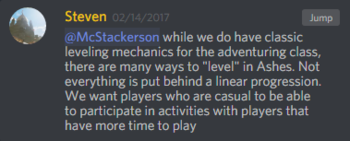
- ↑ Livestream, October 31, 2023 (5:27).
- ↑ 16.0 16.1 16.2 Podcast, December 3, 2023 (15:05).
- ↑ 17.0 17.1 Livestream, May 27, 2022 (1:11:10).
- ↑ Livestream, May 24, 2017 (46:27).
- ↑ Livestream, July 25, 2020 (1:33:37).
- ↑ 20.0 20.1 Livestream, July 29, 2022 (1:24:58).
- ↑ 21.0 21.1 21.2 Interview, June 13, 2021 (48:27).
- ↑ 22.0 22.1 22.2 Livestream, September 27, 2018 (52:41).
- ↑ 23.0 23.1 Livestream, July 25, 2020 (1:34:55).
- ↑ Livestream, April 29, 2022 (1:06:34).
- ↑ 25.0 25.1 25.2 Interview, July 9, 2023 (42:51).
- ↑ 26.0 26.1 26.2 26.3 Video, April 5, 2018 (40:08).
- ↑ 27.0 27.1 Podcast, July 15, 2023 (11:21).
- ↑ Livestream, December 15, 2017 (58:48).
- ↑ 29.0 29.1 Interview, July 8, 2020 (1:07:59).
- ↑ Livestream, May 24, 2017 (19:25).
- ↑ Livestream, April 30, 2021 (41:18).
- ↑ Livestream, December 19, 2023 (1:41:54).
- ↑ Livestream, March 31, 2023 (1:24:21).
- ↑ Livestream, January 28, 2022 (15:35).
- ↑ Interview, July 8, 2020 (1:12:51).
- ↑ 36.0 36.1 36.2 Livestream, May 15, 2017 (26:13).
- ↑ Interview, August 24, 2018 (4:15).
- ↑ 38.0 38.1 38.2 38.3 38.4 Livestream, September 30, 2020 (1:07:22).
- ↑ Interview, August 24, 2018 (8:52).
- ↑ 40.0 40.1 Livestream, May 31, 2023 (43:55).
- ↑ Interview, June 13, 2021 (24:14).
- ↑ 42.0 42.1 42.2 42.3 Livestream, July 28, 2023 (1:04:27).
- ↑ 43.0 43.1 43.2 43.3 43.4 43.5 43.6 Interview, July 18, 2020 (1:05:04).
- ↑ 44.0 44.1 44.2 44.3
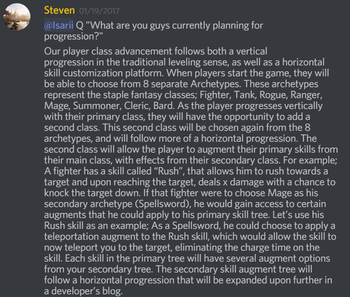
- ↑ 45.0 45.1 45.2 Interview, July 29, 2020 (54:44).
- ↑ 46.0 46.1 46.2 Ashes of Creation class list.
- ↑ 47.0 47.1 47.2 47.3 Livestream, July 28, 2017 (19:05).
- ↑ 48.0 48.1

- ↑ Livestream, May 3, 2017 (50:50).
- ↑ Livestream, July 18, 2017 (37:43).
- ↑ 51.0 51.1 Livestream, July 31, 2020 (1:31:11).
- ↑ Podcast, April 11, 2021 (54:35).
- ↑
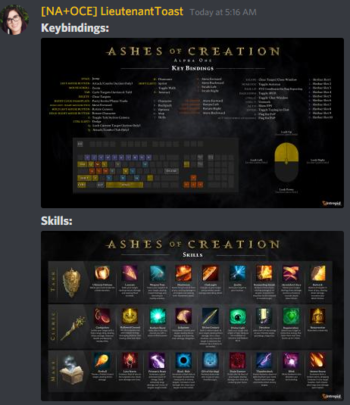
- ↑ Livestream, October 16, 2017 (1:00:44).
- ↑ Interview, August 8, 2018 (22:27).
- ↑ 56.0 56.1 Livestream, December 19, 2023 (1:20:41).
- ↑

- ↑ 58.0 58.1 58.2 58.3 Livestream, November 19, 2021 (50:38).
- ↑ Video, September 30, 2022 (17:00).
- ↑ Livestream, September 24, 2021 (1:18:06).
- ↑ 61.0 61.1 Video, December 19, 2023 (5:29).
- ↑ 62.0 62.1 62.2 Livestream, July 28, 2023 (1:03:27).
- ↑ Interview, July 29, 2020 (55:44).
- ↑ 64.0 64.1 Interview, July 19, 2020 (53:59).
- ↑ 65.0 65.1 Interview, July 18, 2020 (1:07:51).
- ↑ Livestream, August 28, 2020 (1:19:24).
- ↑ 67.0 67.1 67.2 67.3 Livestream, December 19, 2023 (1:49:56).
- ↑ Livestream, December 19, 2023 (1:46:12).
- ↑ Forums - Livestream Q&A 2022-08-26.
- ↑ Interview, July 18, 2020 (1:07:06).
- ↑ Livestream, November 16, 2017 (30:02).
- ↑ Livestream, December 2, 2022 (1:05:08).
- ↑ Livestream, April 30, 2021 (53:08).
- ↑ 74.0 74.1 Interview, October 20, 2018 (2:53:52).
- ↑ 75.0 75.1 75.2 Livestream, January 30, 2020 (1:28:40).
- ↑ Livestream, May 4, 2018 (45:37).
- ↑ Livestream, June 30, 2022 (1:12:38).
- ↑ Livestream, September 30, 2022 (53:15).
- ↑ Livestream, September 30, 2022 (43:45).
- ↑ Video, September 30, 2022 (24:49).
- ↑ Podcast, September 29, 2021 (47:57).
- ↑ Interview, February 7, 2021 (49:18).
- ↑ 83.0 83.1 February 8, 2019 - Questions and Answers.
- ↑ 84.0 84.1 84.2 84.3 84.4 84.5 Livestream, June 4, 2018 (1:11:19).
- ↑ Livestream, June 25, 2021 (1:29:39).
- ↑ 86.0 86.1 86.2 Podcast, December 3, 2023 (17:10).
- ↑ 87.0 87.1 87.2 87.3 87.4 Livestream, November 30, 2023 (1:38:47).
- ↑ Video, November 30, 2023 (1:01:04).
- ↑ Video, November 30, 2023 (59:21).
- ↑ Livestream, May 26, 2017 (5:25).
- ↑

- ↑ Livestream, November 30, 2023 (1:54:37).
- ↑ Livestream, June 4, 2018 (21:37).
- ↑ 94.0 94.1 94.2 94.3 94.4 Interview, July 18, 2020 (16:34).
- ↑ Interview, July 18, 2020 (14:22).
- ↑ 96.0 96.1 Livestream, May 27, 2022 (1:20:00).
- ↑ Livestream, May 26, 2017 (51:37).
- ↑ Livestream, May 17, 2017 (58:55).
- ↑ 99.0 99.1 Livestream, March 26, 2021 (1:15:57).
- ↑ 100.0 100.1 Livestream, November 30, 2020 (1:26:00).
- ↑
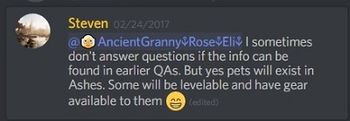
- ↑ 102.0 102.1 102.2 Interview, January 14, 2022 (42:18).
- ↑ Livestream, October 30, 2020 (1:21:14).
- ↑ Livestream, June 28, 2019 (1:24:27).
- ↑ Livestream, July 30, 2021 (1:15:29).
- ↑ 106.00 106.01 106.02 106.03 106.04 106.05 106.06 106.07 106.08 106.09 106.10 106.11 106.12 106.13 106.14 106.15

- ↑ 107.0 107.1 107.2 107.3 107.4 107.5 107.6 107.7 107.8 107.9 Video, November 30, 2023 (37:12).
- ↑ 108.0 108.1 108.2 108.3 108.4 Development Update with Freehold Preview.
- ↑

- ↑ 110.0 110.1 110.2 Video, November 30, 2023 (9:36).
- ↑ Livestream, June 30, 2023 (50:07).
- ↑ 112.0 112.1 112.2 112.3 Podcast, December 3, 2023 (14:14).
- ↑ Podcast, December 3, 2023 (2:53).
- ↑ 114.0 114.1 114.2 114.3 114.4 114.5
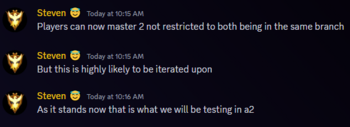
- ↑ Video, November 30, 2023 (23:20).
- ↑ 116.0 116.1 116.2 Video, November 30, 2023 (16:40).
- ↑ Interview, February 7, 2021 (36:38).
- ↑ 118.0 118.1

- ↑ 119.0 119.1 Livestream, April 29, 2022 (1:13:00).
- ↑ Livestream, July 26, 2019 (1:09:46).
- ↑ Livestream, May 24, 2017 (32:07).
- ↑ Podcast, December 3, 2023 (10:22).
- ↑ Video, November 30, 2023 (26:38).
- ↑ 124.0 124.1 Video, November 30, 2023 (36:00).
- ↑
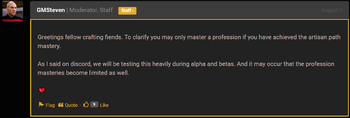
- ↑

- ↑ 127.0 127.1 Podcast, December 3, 2023 (6:23).
- ↑

- ↑ Livestream, May 10, 2017 (6:12).
- ↑ 130.0 130.1 130.2 Livestream, April 7, 2023 (1:00:55).
- ↑ Livestream, October 28, 2022 (1:32:38).
- ↑

- ↑ Interview, July 20, 2020 (18:47).
- ↑

- ↑

- ↑
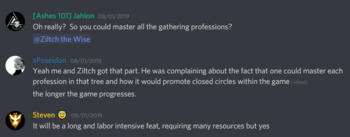
- ↑

- ↑

- ↑ Video, November 30, 2023 (7:56).
- ↑ 140.0 140.1 140.2 140.3 Video, November 30, 2023 (5:58).
- ↑ 141.0 141.1 141.2 141.3 141.4 141.5 Video, June 30, 2023 (3:14).
- ↑ Livestream, October 14, 2022 (32:38).
- ↑ 143.0 143.1 Interview, March 27, 2020 (9:00).
- ↑ 144.0 144.1 144.2 Interview, May 11, 2018 (38:25).
- ↑ 145.0 145.1 Livestream, December 19, 2023 (1:53:02).
- ↑ 146.0 146.1 Video, October 28, 2022 (26:14).
- ↑ Podcast, December 3, 2023 (12:27).
- ↑ 148.0 148.1 Video, October 28, 2022 (25:11).
- ↑ 149.0 149.1 Livestream, April 30, 2020 (53:11).
- ↑ 150.0 150.1

- ↑ Interview, July 18, 2020 (1:00:15).
- ↑ Interview, July 19, 2020 (8:43).
- ↑ 153.0 153.1 153.2 153.3 153.4 Interview, July 20, 2020 (21:57).
- ↑ 154.0 154.1 154.2 154.3 Livestream, 2018-04-8 (PM) (55:49).
- ↑ Livestream, July 25, 2020 (46:08).
- ↑ Livestream, March 26, 2021 (1:02:06).
- ↑ 157.0 157.1 Livestream, March 31, 2022 (1:15:02).
- ↑ 158.0 158.1 Livestream, May 15, 2017 (38:08).
- ↑ 159.0 159.1 Livestream, July 9, 2018 (25:34).
- ↑ Livestream, 2018-04-8 (PM) (51:49).
- ↑ Livestream, May 19, 2017 (44:18).
- ↑ 162.0 162.1 162.2 162.3 162.4 Livestream, July 25, 2020 (57:02).
- ↑ 163.0 163.1 163.2 Livestream, May 8, 2017 (44:51).
- ↑

- ↑ Livestream, June 1, 2017 (33:40).
- ↑ 166.0 166.1 166.2 166.3 166.4 166.5 166.6 Livestream, September 30, 2022 (1:24:54).
- ↑ 167.0 167.1 167.2 167.3 167.4 167.5 167.6 Livestream, July 9, 2018 (36:05).
- ↑ Livestream, July 9, 2018 (36:05).
- ↑ 169.0 169.1 Livestream, April 29, 2022 (44:13).
- ↑ Video, September 29, 2023 (12:18).
- ↑ Video, September 29, 2023 (2:59).
- ↑

- ↑ 173.00 173.01 173.02 173.03 173.04 173.05 173.06 173.07 173.08 173.09 173.10 Blog - Know Your Nodes - Advance and Destroy.
- ↑ 174.00 174.01 174.02 174.03 174.04 174.05 174.06 174.07 174.08 174.09 174.10 Blog - Know Your Nodes - The Basics.
- ↑ 175.0 175.1 175.2 A reactive world - Nodes.
- ↑ Livestream, December 12, 2018 (14:48).
- ↑ Interview, July 20, 2020 (3:45).
- ↑ Video, February 29, 2024 (33:57).
- ↑ Video, April 20, 2017 (0:02).
- ↑
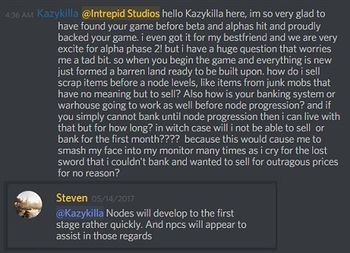
- ↑ Node series part II – the Metropolis.
- ↑ 182.0 182.1 Livestream, October 16, 2017 (50:20).
- ↑ 183.0 183.1 183.2

- ↑ 184.0 184.1 184.2 184.3

- ↑ Livestream, February 29, 2024 (53:58).
- ↑ 186.0 186.1 Interview, July 18, 2020 (10:04).
- ↑ 187.0 187.1 Interview, July 8, 2020 (1:00:15).
- ↑
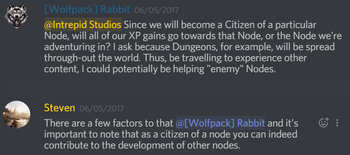
- ↑ Livestream, September 24, 2021 (1:21:23).
- ↑ 190.0 190.1 Livestream, May 26, 2017 (28:16).
- ↑ 191.0 191.1 191.2 191.3 191.4 Livestream, October 14, 2022 (55:13).
- ↑ Livestream, November 17, 2017 (55:27).
- ↑ 193.0 193.1 193.2 193.3 Livestream, August 26, 2022 (1:07:34).
- ↑

- ↑ Livestream, August 31, 2023 (52:56).
- ↑ 196.0 196.1 Livestream, August 26, 2022 (1:04:35).
- ↑

- ↑ 198.0 198.1 198.2 Livestream, August 26, 2022 (1:10:16).
- ↑ 199.0 199.1 199.2 Livestream, October 30, 2020 (39:17).
- ↑ 200.0 200.1 200.2 200.3 200.4 200.5 Livestream, September 27, 2018 (53:06).
- ↑ 201.0 201.1 Livestream, February 25, 2022 (41:00).
- ↑ 202.0 202.1 Livestream, February 26, 2021 (1:12:18).
- ↑ 203.0 203.1 203.2 203.3 203.4 Livestream, March 31, 2022 (4:57).
- ↑ Podcast, April 11, 2021 (29:47).
- ↑ Interview, May 11, 2018 (54:34).
- ↑ Livestream, May 26, 2017 (21:23).
- ↑ Podcast, April 11, 2021 (23:36).
- ↑ 208.0 208.1 Interview, May 11, 2018 (47:27).
- ↑ 209.0 209.1 Livestream, July 29, 2022 (1:13:09).
- ↑ Livestream, June 26, 2020 (45:32).
- ↑ 211.0 211.1 Interview, February 7, 2021 (33:00).
- ↑ 212.0 212.1 Interview, May 11, 2018 (1:00:19).
- ↑ Interview, July 19, 2020 (19:35).
- ↑ Livestream, May 15, 2017 (30:53).
- ↑ Livestream, August 26, 2022 (1:28:50).
- ↑ Interview: Ashes of Creation on Building Their Virtual World, 2017-04-13.
- ↑ 217.00 217.01 217.02 217.03 217.04 217.05 217.06 217.07 217.08 217.09 217.10 217.11 Livestream, September 27, 2018 (55:39).
- ↑ 218.0 218.1 218.2 Livestream, May 19, 2017 (22:10).
- ↑ 219.0 219.1 Interview, July 19, 2020 (36:07).
- ↑

- ↑ Livestream, June 26, 2020 (1:31:53).
- ↑ 222.0 222.1 Livestream, May 5, 2017 (23:26).
- ↑ Interview, August 8, 2018 (9:36).
- ↑ Livestream, October 30, 2020 (1:11:13).
- ↑ 225.0 225.1 225.2 Livestream, May 17, 2017 (7:27).
- ↑ Livestream, September 29, 2023 (1:07:50).
- ↑ Interview, July 19, 2020 (24:34).
- ↑ 228.0 228.1 228.2 228.3 Podcast, May 11, 2018 (18:52).
- ↑ Podcast, September 29, 2021 (30:04).
- ↑ Livestream, June 25, 2021 (1:05:01).
- ↑ 231.0 231.1 231.2 Podcast, April 23, 2018 (24:47).
- ↑ 232.0 232.1 Livestream, June 1, 2017 (31:47).
- ↑ 233.0 233.1 233.2 233.3 233.4 Podcast, May 11, 2018 (21:07).
- ↑ Livestream, August 31, 2023 (2:10:23).
- ↑ 235.0 235.1 235.2 Podcast, May 11, 2018 (48:29).
- ↑ Livestream, April 7, 2023 (31:49).
- ↑ Livestream, June 30, 2022 (1:08:02).
- ↑ 238.0 238.1 Livestream, December 2, 2022 (1:22:30).
- ↑ 239.0 239.1 239.2 Podcast, April 23, 2018 (29:56).
- ↑ Livestream, June 30, 2023 (27:52).
- ↑

- ↑ Livestream, May 3, 2017 (31:46).
- ↑ Livestream, May 3, 2017 (36:25).
- ↑
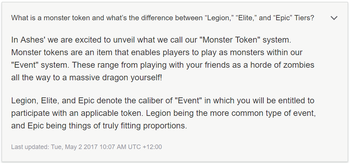
- ↑ 245.0 245.1 Livestream, June 30, 2023 (1:50:52).
- ↑
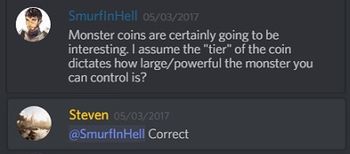
- ↑ 247.0 247.1 Livestream, September 24, 2021 (1:22:46).
- ↑ Livestream, January 31, 2024 (59:45).
- ↑ 249.0 249.1 249.2 Livestream, October 31, 2023 (1:11:26).
- ↑ 250.0 250.1 Livestream, June 30, 2022 (1:14:52).
- ↑ 251.0 251.1 Livestream, August 27, 2021 (1:22:56).
- ↑ 252.0 252.1 252.2 Livestream, February 26, 2021 (1:16:21).
- ↑ 253.0 253.1 253.2 253.3 253.4 253.5 Video, January 31, 2024 (10:15).
- ↑ Livestream, August 23, 2017 (16:44).
- ↑

- ↑ 256.0 256.1 Podcast, May 11, 2018 (52:20).
- ↑

- ↑ 258.0 258.1 258.2 258.3 Livestream, June 25, 2021 (1:12:37).
- ↑ 259.0 259.1 259.2 259.3 Interview, July 29, 2020 (14:28).
